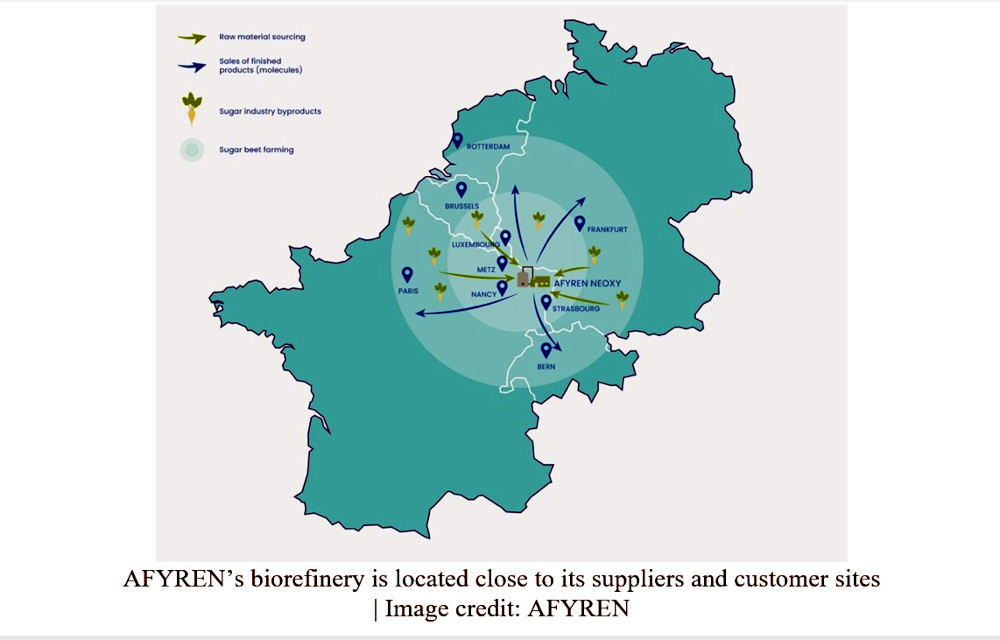Europe in the 19th century, the US in the 20th century, and China in
recent decades have all experienced exponential economic growth by “scaling up”
vertical manufacturing — that is, by centralizing industrial activities in large
factories. But this energy-intensive mass production model has depleted natural
resources
and seriously damaged our environment (the industrial sector accounts today for
nearly
one-third
of US greenhouse gas emissions).
Today, a massive reindustrialization is
underway
in the US and Europe as Western nations try to bring back
manufacturing
that they previously outsourced to low-cost nations such as China. Learning from
the past, US and European manufacturers should avoid scaling up vertically their
operations in gigafactories. Instead, they should “scale out” horizontally —
using a distributed supply network with many small, hyper-agile factories
located closest to customers (see Figure below).
The multiple benefits of scaling out manufacturing
By scaling out their manufacturing and producing in small factories located
closer to customers, businesses can reap many benefits:
Slash fixed costs and operating expenses
How companies around the world are ‘doing better with less’
Join us as Navi Radjou shares more insights and case studies about the frugal economy and its already transformative impact on businesses, industries, communities and the environment — at SB’24 San Diego (October 14-17).
Businesses can avoid the huge capital expenditures (CapEx) needed to build and
run giant high-volume factories. For example, Tesla intends to invest $10
billion
to construct its gigafactory in Mexico — which is nearly twice more than
its Berlin
gigafactory.
In comparison, French electric mobility startup Avatar
Mobilité is building a network of micro-factories
that can be set up cost-effectively and rapidly across France and in
developing nations. Avatar is the creator of
Ulive — an ultralight
electric vehicle that weighs only 350 kg (771 pounds) and consumes three times
less energy than a traditional EV. In each Avatar micro-factory — no bigger than
a spacious garage — local entrepreneurs can assemble the Ulive in a matter of
hours. The Ulive is sold at €15,000 ($16,600), which is a bargain compared to
EVs sold in the US that cost on average
$60,544.
Shrink logistics costs
Firms can curb inbound logistics costs by sourcing raw materials and components
locally, removing the need to transport them from various distant suppliers to a
centralized factory. And by selling their finished products directly to
customers located near their micro-factory, businesses can forego intermediaries
and slash distribution expenses and emissions by avoiding shipping to distant
points of consumption.
For instance, Canadian startup Relocalize is on a
mission to decarbonize and hyper-localize food and beverage production — which
contributes 37 percent of global GHG emissions. Relocalize’s high-tech
micro-factories can produce, package and pelletize food and beverage items on
the spot at grocery distribution centers — hence, removing middle-mile logistics
and drastically reducing GHG emissions, water use and plastic pollution.
Relocalize’s first solution is an autonomous micro-factory — which can fit
inside a repurposed shipping
container
— that can produce packaged ice in certified plastic-negative
bags on-demand and on-site at retailer
distribution and fulfillment centers. This eliminates the crazy need to ship
ice over 1,500
miles
to distribution centers, as it’s done today.
Boost resilience and agility
Distributed manufacturing offers greater supply chain
redundancy
than centralized production. In case micro-factory X in location A malfunctions,
micro-factory Y in nearby location B can take over the tasks and complete
pending customer requests. Even better, you can expedite a “factory in a
box”
— a pre-assembled manufacturing facility in a container — that can be quickly
set up at location A for emergency production while micro-factory X is being
repaired.
For example, global biopharmaceutical firm Bayer piloted a flexible
manufacturing project named F3 (flexible, fast and future)
Factory — a portable,
modular production unit designed to fit within a container. This mobile factory
can quickly be deployed at the customer’s industrial location to manufacture and
distribute a variety of customized chemicals in small quantities. The F3 pilot
project demonstrated a 40 percent decrease in capital investments, 30 percent
energy savings, 30 percent reduction in CO2 footprint, and a significant
improvement in time to market.
Deliver personalized goods flexibly and profitably
During the 19th and 20th centuries, firms scaled up their production in
ever-larger factories to achieve economies of scale. They vied to lower
expenses by mass-producing standardized goods. Today, however, eco-conscious
buyers seek customized
products
that are made closer to where they
live.
Therefore, businesses need to revamp their industrial model in order to achieve
economies of
scope. They must
learn to produce cost-effectively, in low volume, a wide variety of personalized
products in digitally optimized micro-factories located in proximity to
customers. To realize economies of scale, you must
become more efficient. To achieve economies of scope, you must boost your
agility.
AI-powered industrial automation solutions can deliver this agility. San
Francisco-based startup Bright Machines
(BM) has created totally automated and easily configurable micro-factories, with
which users can produce a wide range of items — from electronics to home
appliances — near the customer, enabling flexible and eco-friendly
manufacturing. Using BM’s flexible automation solutions, customers have been
able to launch new products 28 times quicker compared to manual assembly and
boost their production throughput by 2.5 times.
Become more sustainable
By outfitting their micro-factories with digital fabrication technologies
(DFTs) such as CNC machining and 3D
printing,
companies can achieve four advantages:
-
utilize fewer raw materials
-
produce less waste
-
reduce their carbon footprint, and
-
lower transportation expenses.
Additive
manufacturing
(a fancy name for 3D printing) is “frugal,” as it generates 70-90 percent less
waste
compared to traditional manufacturing methods.
Industry
4.0
players including Xometry,
Protolabs and Sybridge operate
a distributed network of small-scale factories run by DFTs such as 3D printers
that eliminate the necessity of transporting components across the globe to be
assembled in a large, centralized factory. Instead, design data for a new
product can be electronically transferred to the micro-factory located closest
to a customer, where it can be 3D printed rapidly using materials that are
easily accessible in that area.
Maximize social impact in local communities
Businesses can build capacity and regenerate “left-behind” communities — such as
former coal-mining towns in the US hinterland — by setting up micro-factories
that would source from small suppliers situated nearby and train and employ
local talent.
For instance, textile-waste recycling company Re-Fresh
Global sets up microfactories in underdeveloped
communities
under a franchising model. Each recycling micro-factory, run by an entrepreneur,
employs people in the local community who also learn valuable skills to succeed
in a circular
economy. Re-Fresh
is a great example of “triple
regeneration”
(to be covered in Part 4 in this series) — a holistic approach to creating
economic, social and ecological value synergistically in disadvantaged places.
Case study: How AFYREN is scaling out the $30 trillion bioeconomy
The bioeconomy aims to
replace the toxic and polluting “petro-sourced” materials used in industrial
value chains with cleaner, “biobased” materials. The bioeconomy holds immense
growth potential: The European bioeconomy is already worth €2.4 trillion
euros;
while the US bioeconomy is today valued at over $1
trillion,
or 5 percent of US GDP. Estimated at $4
trillion
today, the global bioeconomy is poised to grow to $30
trillion
by 2050.
AFYREN is a French startup shaping the bioeconomy. It’s
NEOXY plant in Northeastern France is
a biorefinery that “upcycles” agricultural residues into seven valuable
biomolecules called carboxylic organic acids — used in fields including
animal and human nutrition, cosmetics and lubricants. AFYREN has optimized
NEOXY’s industrial processes, so it produces five times less CO2 and greenhouse
gas emissions compared to traditional methods of producing acids from fossil
fuels.
AFYREN projects a $15 billion global market for its seven biobased organic
acids. What makes its operating model most intriguing is that the majority of
its suppliers are situated within a 250 km (155 miles) radius of its NEOXY
factory (see Figure below). NEOXY supplies global customers through its
industrial facilities in Western Europe for further product processing.

In 2023, AFYREN teamed up with Mitr Phol — a
leading global sugar industry player headquartered in Bangkok, Thailand. The
plan is to establish a second biorefinery in
Thailand
to transform sugarcane byproducts from local suppliers into high-value biobased
products for Asian markets, which account for 25 percent of global carboxylic
acid demand.
AFYREN is considering the option of establishing its third biorefinery in the
United States that will transform agricultural waste — such as corn
byproducts
— sourced from US farmers into valuable products for the North American market.
Instead of scaling up its manufacturing by centralizing all its production in a
single, giant factory that would supply all global markets, AFYREN wisely
decided to “scale out” by running modestly sized factories located in two vital,
regional markets: Europe and Asia.
Every biorefinery solely utilizes raw materials abundantly available locally and
caters mostly to regional clients. AFYREN’s hyper-local bioeconomy value chains
minimize carbon footprint and maximize the livelihoods of local farmers, who
earn more by selling their agricultural
waste.
By scaling out their manufacturing with a distributed network of agile
micro-factories rooted in local communities, businesses can gain in agility and
resilience and produce and deliver personalized goods faster, better, cheaper
and more sustainably.
Read more about the frugal economy:
This article has been partially adapted from the author’s upcoming book, The
Frugal Economy: A Guide to Building a Better World with
Less (2024),
published by Wiley and Thinkers50.


